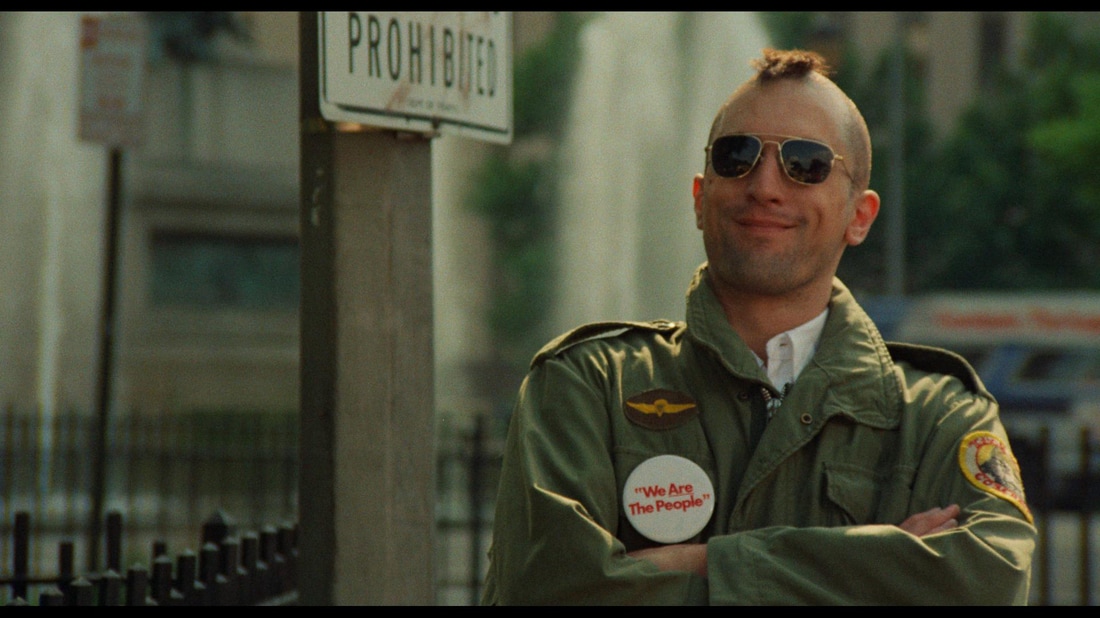 By Mark Young | One will never forget their first Scorsese film. Mine was Goodfellas,(1990). The opening sequence both terrified me and drew me in. The violence was striking and blatant. Scorsese’s depiction of the criminal underpinnings of New York city in the 1960s and 1970s was casual, disturbing, and all too realistic. Yet through the moral exploration of violence, machismo, and crime that has defined Scorsese’s career I saw something new to me. I saw brilliance in a film. |
Taxi Driver is the pivotal film in Scorsese’s career, Scorsese moves into making the films that are more personal and carry the experience of a young boy growing up in Queens. In Mean Streets (1973) Scorsese began to define his style but by Taxi Driver he had fully come into his own as an auteur. In Taxi Driver you see the careful mindful control of an artist who is passionate about his work. An auteur leaves part of themselves in a film. They truly put their soul into their work. So much so that it bears such a distinct piece of them that even the most casual movie goer can recognize. What is called a director’s “style” is actually the craftsmanship of an auteur.
Counter to Woody Allen’s approach where he spends his time romanticizing New York City in Manhattan (1979) and many other New York City films, Scorsese seemed to relish in tearing this image down. New York City is de-romanticized by Scorsese’s Taxi Driver. Through Travis Bickle’s journey everything about the city is torn down. We are shown a constant barrage of decadence, darkness, and debauchery. Even the images of the city during the day time take place mainly in pornographic theaters or Travis’ apartment which is small and disorganized much like his broken mind.
Travis views himself as a soldier, someone on a mission. He sees the city and desires to do something about it. This plays significantly in the few relationships he has, namely the two women Betsy and Iris. Betsy and Iris are catalysts to Travis inaction. His interactions with these two women, one a young girl, give him the outlet for his frustration with the evil in the city.
Travis awkward interaction in a cab ride with Senator Palantine sets the stage for his murder plot. Travis was sold out for Palantine as the next president, due in part to his relationship with Betsy. Yet, after Travis has a chance to talk to Palantine he learns that Palantine is just another suit. A man who will talk about the problems, but seems unwilling to commit to the change that Travis deems needed. This interaction proves Palantine is part of the problem. He is part of a bureaucracy that uses people to suit their own purposes.
Iris is the converse of the problem in the city. She is a victim of the underbelly that is holding her down and using her to suit Sport’s purposes. Where Palantine is a subversive problem Sport is overt. He is a pimp. He is a scumbag and most likely knows it. He doesn’t really care for Iris, although he may have convinced her he does. Sport is the cancerous tumor, Palantine is the cancerous cell.
Travis has convinced himself that his goals are noble. He hopes to save these women from their traps and fulfill his desire to fix the city. In the end, Travis accomplishes only one of his murderous plots. And in so doing he is hailed as a hero. The news pieces the story together as best they can and decide that instead of the story we have just seen unfold they decide that Travis is a hero. He killed three lowlife degenerates caught up in a child prostitution ring. This mentally disturbed taxi driver, who planned to murder politicians and pimps alike, is hailed a hero simply for the sensationalism of the story. It will sell papers. It gives people hope in the midst of this madness. So the narrative the media creates becomes the truth. No jury would convict him if brought to trial.
This speaks to larger problems with the society as a whole. If you take the life of someone deemed scum you can be a hero. If Travis had killed Palantine he would have been considered a villain. He would have taken out someone who is just as much a part of the problem and yet our society has decided it is willing to live with certain kinds of villains and willing to look the other way on others. We ARE the people. WE are the people. The problem with the buttons is not that the slogan is wrong but that they speak too much truth. By emphasizing the “We” it shows exactly where the responsibility for the city’s problems lie. By emphasizing the “Are” it makes the people feel as if they have taken action. In reality, the people are caught in an incredible cycle of inaction.
The headlights at the end show us a sea of people going about their lives in the city. We lose track of the taxi and are left to wonder if Travis is okay. Who knows if his need for violence is over, or simply satiated for the time being. The lights give us no hope, we are left questioning if anything has actually changed.

The film has recently gone through a 4K restoration, effectively bringing this classic into the modern era of filmmaking. Scorsese stated that the film drove him. He could not state explicitly what about the film connected with him he simply knew that, “It had to be made.” This pull controlled the production process. It inspired each actor to take in depth looks into their characters. DeNiro even drove a cab at night for ten days.
Still Jodi Foster revealed that her young age at the time almost cost the film it’s most iconic shot. She was only twelve years old and her social worker and mother held firm that her work day could not be extended. Scorsese was forced to rise to the occasion and captured the ending sequence in a mere two takes. No room was left for error. Scorsese was able to prove his master craftsmanship behind the camera and displayed the violence in a single tracking shot.
Scorsese implied that it was the hardest movie he ever made. The darkness, the grit, and the subject matter almost drove him to simply film on video so he could get this film off his chest. “Even though you’re born right in the city doesn’t mean you don’t feel isolated… and I think we all connected to that,” said DeNiro. The idea that a person could be so lonely, isolated, and struggle with communication in a city of millions is one that still resonates through the years. In many ways everyone can see their self in Travis Bickle.
Works Cited
https://tribecafilm.com/stories/tribeca-film-festival-taxi-driver-anniversary-reunion-martin-scorsese-robert-de-niro-jodie-foster
https://tribecafilm.com/press-center/press-releases/taxi-driver-to-have-40th-anniversary-celebration-at-the-15th-annual-tribeca-film-festival





 RSS Feed
RSS Feed
